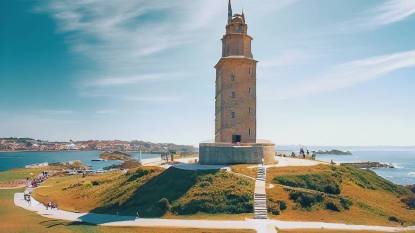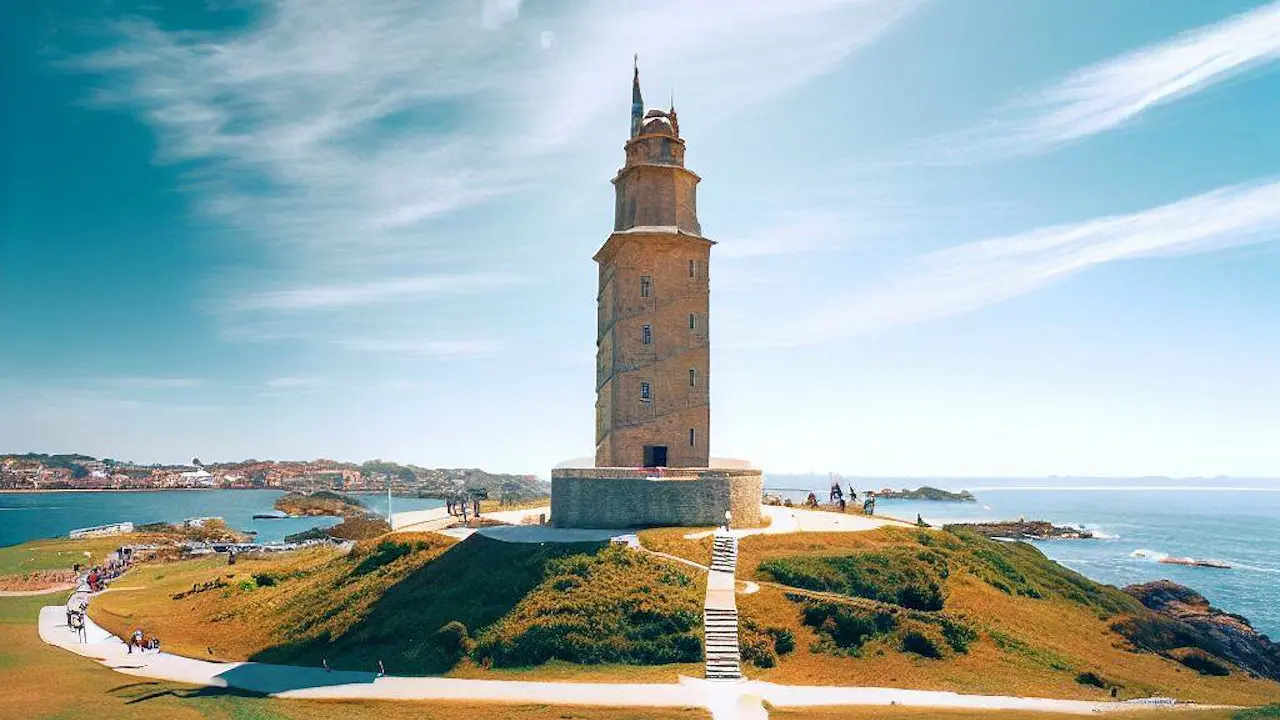
Tower of Hercules: Why is it a UNESCO World Heritage Site?
Posted: | Updated:
Reading time: 29 minutes
Tower of Hercules: Why is it a UNESCO World Heritage Site?
Posted: | Updated:
Reading time: 29 minutes
By: Simon Kemp, Editor
The Tower of Hercules (Galician: Torre de Hércules, Spanish: Torre de Hércules), one of the most dramatic landmarks along the Camino Inglés, is a testament to the architectural prowess and maritime history of ancient civilizations. Located on a peninsula about 2.4 km from the center of A Coruña, Galicia, in northwestern Spain, this tower is the oldest known extant lighthouse in the world. Built in the 1st century, it has been guiding mariners with its light for nearly two millennia.
The tower’s original name was Farum Brigantium, with the term ‘farum’ being derived from the Greek Φάρος, Pharos, for the Lighthouse of Alexandria. This connection to the legendary Lighthouse of Alexandria, one of the Seven Wonders of the Ancient World, underscores the historical significance of the Tower of Hercules.
Standing 55 metres tall, the tower overlooks the North Atlantic coast of Spain. It underwent a significant renovation in 1791, which preserved its ancient core while enhancing its technical functions. The tower is not just a functional lighthouse; it is also a cultural monument. It has been recognized as a National Monument of Spain and was designated a UNESCO World Heritage Site on 27 June 2009.
The grounds of the lighthouse also feature a sculpture garden, showcasing works by artists such as Pablo Serrano and Francisco Leiro. The Tower of Hercules is more than just a lighthouse; it is a beacon of history, a monument of cultural significance, and a symbol of the enduring strength and spirit of A Coruña and Spain.
Torre de Hércules Map
Historical Background
The Tower of Hercules, known to have existed since the 1st century, was built or perhaps rebuilt under the reign of the Roman Emperor Trajan. Its design is believed to be based on the original plans of the Lighthouse of Alexandria, indicating a possible Phoenician origin. The tower’s base preserves a cornerstone with the inscription “MARTI AVG.SACR C.SEVIVS LVPVS ARCHITECTVS ÆMINIENSIS LVSITANVS.EX.VO,” which attributes the tower’s design to the architect Gaius Sevius Lupus, from Aeminium (present-day Coimbra, Portugal) in the former province of Lusitania. This inscription also reveals that the tower was an offering to Mars, the Roman god of war.
The original tower was shorter and wider than the current structure, with a surviving core surrounded by a spiral ramp. The outline of this ramp is still visible in the restored exterior, suggesting that the final story of the tower was likely topped with a dome.
The earliest known reference to the lighthouse at Brigantium is by Paulus Orosius in “Historiae adversum Paganos,” written around 415–417. In 1788, the surviving 34-metre tower core was given a neoclassical restoration, including a new 21-metre fourth story. This restoration was undertaken by naval engineer Eustaquio Giannini during the reign of Charles III of Spain, and was finished in 1791. UNESCO praised the work, stating that the restoration protected the central core of the original Roman monument while restoring its technical functions.
The Romans who conquered this region of Spain believed it to be, in a figurative sense, the end of the Earth – hence its name, Finisterra. This region is notorious for shipwrecks, earning it the name Costa da Morte, or “Coast of Death.”
The tower has been in consistent use since the 2nd century, serving as a beacon for ships navigating the treacherous waters of the North Atlantic. Its enduring presence and function over the centuries underscore its historical significance and the advanced engineering capabilities of the ancient civilizations that constructed it.
One of the many hidden gems of the Camino Inglés , let’s dive into the details:
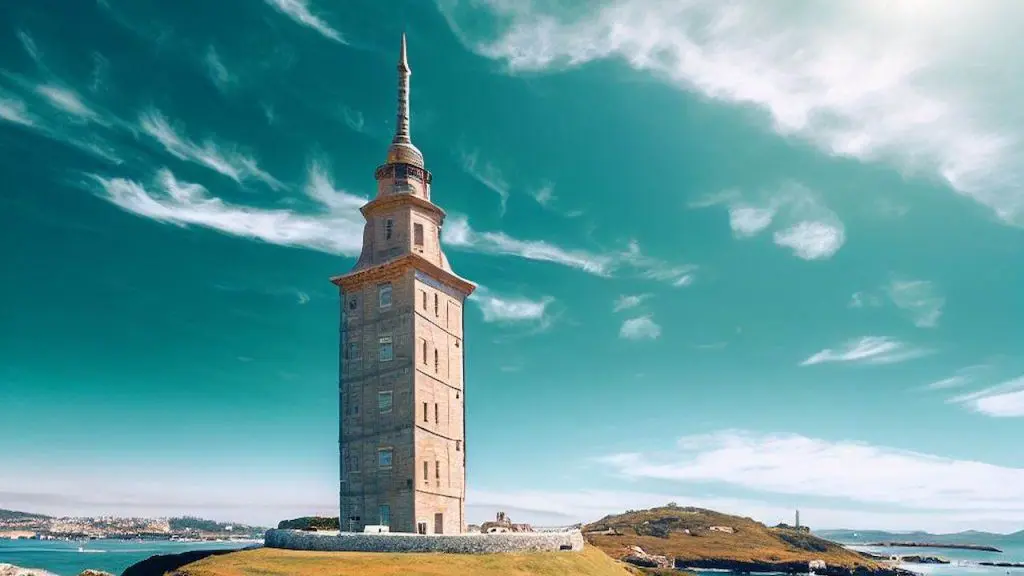
Architectural Details
The Tower of Hercules, standing at a height of 55 meters, is a marvel of ancient architecture and engineering. Its design is believed to be based on the original plans of the Lighthouse of Alexandria, suggesting a Phoenician origin. The tower’s base preserves a cornerstone with an inscription that attributes the tower’s design to the architect Gaius Sevius Lupus, from Aeminium (present-day Coimbra, Portugal) in the former province of Lusitania.
The original tower was shorter and wider than the current structure. The surviving core of the tower was surrounded by a spiral ramp, the outline of which is still visible in the restored exterior. This spiral ramp suggests that the tower was designed to allow for easy access to the top, likely for maintenance and operation of the light. The final story of the tower was likely topped with a dome, which would have served to protect the light source from the elements.
In 1788, the surviving 34-metre tower core was given a neoclassical restoration, including a new 21-metre fourth story. This restoration was undertaken by naval engineer Eustaquio Giannini during the reign of Charles III of Spain, and was finished in 1791. The restoration preserved the central core of the original Roman monument while restoring its technical functions. Within the tower, the much-repaired Roman and medieval masonry remains visible, providing a glimpse into the construction techniques of the time.
The Tower of Hercules is not just a functional lighthouse; it is also a work of art. The grounds of the lighthouse feature a sculpture garden, showcasing works by artists such as Pablo Serrano and Francisco Leiro. These sculptures add a cultural dimension to the tower, enhancing its appeal as a tourist attraction.
The Tower of Hercules is a remarkable example of ancient architecture and engineering. Its design and construction techniques have stood the test of time, allowing it to continue serving its purpose for nearly two millennia. Its restoration and the addition of the sculpture garden have further enhanced its value, making it a must-visit destination for anyone interested in history, architecture, or maritime navigation.
Much older than another of the hidden gems, the Mosteiro de Santa María de Sobrado dos Monxes , the Torre de Hércules will impress and is a must-see destination along the Camino.
Restoration and Modern History
The Tower of Hercules has undergone significant restoration work to preserve its historical and architectural integrity. In 1788, the surviving 34-metre tower core was given a neoclassical restoration, which included the addition of a new 21-metre fourth story. This restoration was undertaken by naval engineer Eustaquio Giannini during the reign of Charles III of Spain and was completed in 1791.
The restoration work was praised by UNESCO, which stated, “The Tower of Hercules was restored in the 18th century in an exemplary manner, which has protected the central core of the original Roman monument while restoring its technical functions.” This restoration work has allowed the tower to continue serving its original purpose as a lighthouse, while also preserving its historical significance.
Within the tower, the much-repaired Roman and medieval masonry remains visible, providing a glimpse into the construction techniques of the time. This blend of ancient and modern elements is a testament to the careful and respectful restoration work that has been carried out on the tower.
In addition to its restoration, the tower has also been recognized for its historical and cultural significance. It has been designated a National Monument of Spain and was recognized as a UNESCO World Heritage Site on 27 June 2009. These designations underscore the tower’s importance as a historical and archaeological site.
The tower continues to be a beacon for ships navigating the North Atlantic, just as it has been since the 2nd century. Its enduring presence and function over the centuries underscore its historical significance and the advanced engineering capabilities of the ancient civilizations that constructed it. Today, the Tower of Hercules stands not only as a functional lighthouse but also as a symbol of A Coruña and Spain’s rich maritime history.
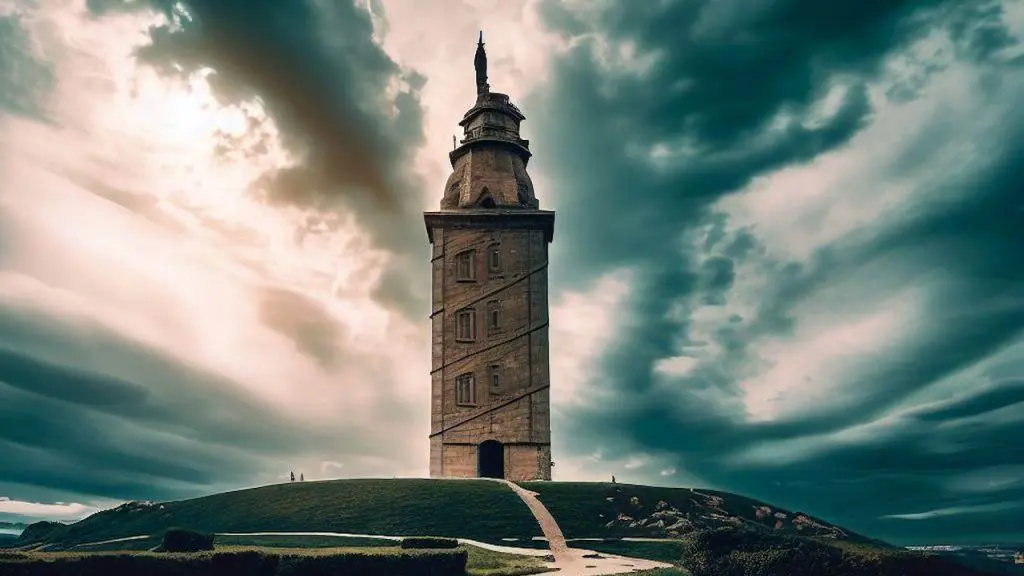
Archaeological Evidence and Associated Artefacts
The Tower of Hercules is a treasure trove of archaeological evidence and associated artefacts that provide insights into the tower’s origins and history. The tower’s base preserves a cornerstone with the inscription “MARTI AVG.SACR C.SEVIVS LVPVS ARCHITECTVS ÆMINIENSIS LVSITANVS.EX.VO,” which attributes the tower’s design to the architect Gaius Sevius Lupus, from Aeminium (present-day Coimbra, Portugal) in the former province of Lusitania. This inscription also reveals that the tower was an offering to Mars, the Roman god of war.
The original tower was shorter and wider than the current structure, with a surviving core surrounded by a spiral ramp. The outline of this ramp is still visible in the restored exterior, providing tangible evidence of the tower’s original design. The final story of the tower was likely topped with a dome, another detail that can be inferred from the surviving architectural features.
Within the tower, the much-repaired Roman and medieval masonry remains visible, providing a glimpse into the construction techniques of the time. This masonry is an important artefact in its own right, as it provides evidence of the tower’s long history and the various stages of its construction and repair.
In addition to these artefacts within the tower itself, other Roman remains have been found in the city center of A Coruña, indicating that the tower was part of a larger Roman settlement. These remains provide further context for the tower’s historical and cultural significance.
In summary, the Tower of Hercules is a rich source of archaeological evidence and associated artefacts. These artefacts, from inscriptions to architectural features to Roman remains in the surrounding area, provide valuable insights into the tower’s origins, history, and cultural significance.
Myths and Legends
The Tower of Hercules is steeped in a rich tapestry of myths and legends that have been passed down through the centuries. These stories often blend Celtic and Greco-Roman elements, adding a layer of mystique to the tower’s history.
One of the most enduring myths associated with the tower is the story of the hero Hercules. According to this myth, Hercules slew the giant tyrant Geryon after three days and three nights of continuous battle. In a traditional Celtic gesture, Hercules buried the head of Geryon with his weapons and ordered that a city be built on the site. The lighthouse, standing atop a skull and crossbones representing the buried head of Hercules’ slain enemy, appears in the coat of arms of the city of A Coruña.
Another legend from the 11th-century Irish compilation Lebor Gabála Érenn—the “Book of Invasions”—tells the story of King Breogán, the founding father of the Galician Celtic nation. According to this legend, Breogán constructed a massive tower of such a grand height that his sons could see a distant green shore from its top. The glimpse of that distant green land lured them to sail north to Ireland. According to the legend, Breogán’s descendants stayed in Ireland and are the Celtic ancestors of the current Irish people. A colossal statue of Breogán has been erected near the Tower.
Throughout the Middle Ages, multiple naval crusading itineraries to the Holy Land mentioned the obligatory stopover at the Lighthouse. Usually, the crusader fleets would disembark there to reach the shrine of the Apostle James the Greater at Santiago de Compostela on foot. De expugnatione Lyxbonensi and De itinere Frisunum helped to perpetuate the legend that the lighthouse had been built by Julius Caesar perhaps due to a misreading of the ancient inscription.
These myths and legends add a layer of cultural and historical significance to the Tower of Hercules, enhancing its appeal as a symbol of A Coruña and Spain’s rich maritime history.
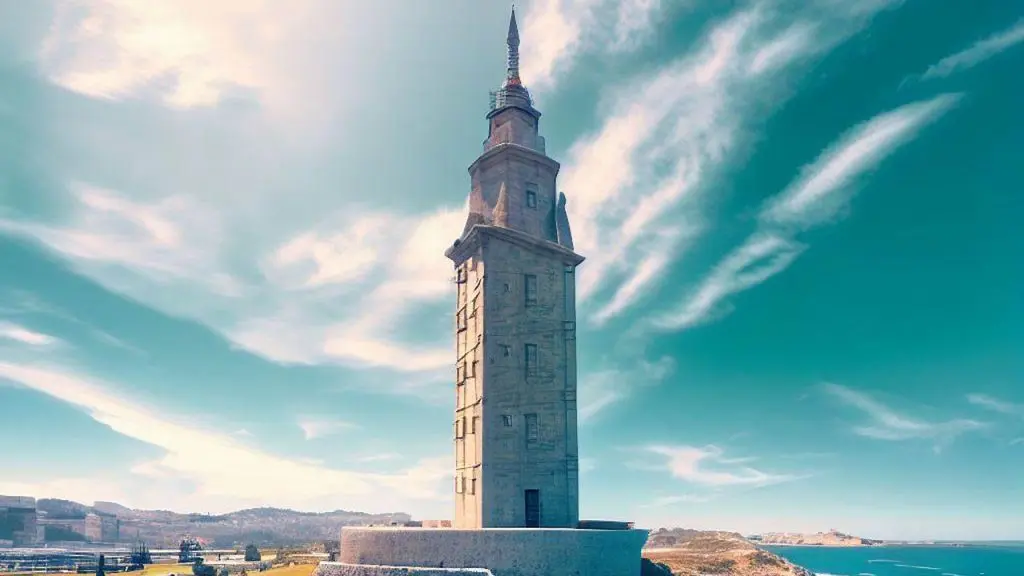
Relevance of Brigantia
The first mention of Brigantia in historical records is somewhat unclear due to the ancient nature of the site and the fact that many ancient texts have been lost over time. However, it’s generally agreed that Brigantia was known to the Romans and is likely mentioned in some of their texts.
One of the earliest known references to a place called Brigantia comes from Ptolemy’s “Geographia,” a Greek work from the 2nd century AD. Ptolemy was a Roman citizen of Egypt who wrote in Greek. In his work, he describes the geography of the known world, including many places in the Roman Empire. However, it’s important to note that there were several places known as Brigantia in the ancient world, and not all of them refer to the same location.
In the context of the Tower of Hercules and the city of A Coruña, the term Brigantia is often associated with the ancient Roman and Celtic peoples who lived in the region. The tower itself is sometimes referred to as the “Farum Brigantium,” indicating its location in or near the place known as Brigantia.
The relevance of Brigantia in the context of the Tower of Hercules and the history of the region cannot be overstated. Brigantia, believed to be either A Coruña or Betanzos, is thought to be the ancient city associated with the construction of the tower. Understanding the location of Brigantia provides crucial context for the tower’s origins and its historical significance.
Brigantia is believed to have been a significant Roman settlement, and its port would have been a crucial hub for maritime activities in the region. The construction of the Tower of Hercules in this location underscores the importance of Brigantia as a strategic maritime location during the Roman era.
Moreover, the debate over the location of Brigantia sheds light on the complex history of the region, including shifts in population, changes in maritime practices, and the evolution of place names. It highlights the rich tapestry of cultural, historical, and linguistic influences that have shaped this part of Spain.
The relevance of Brigantia also extends to the field of archaeology. The search for the location of the ancient city has led to numerous archaeological discoveries, including Roman remains in the city center of A Coruña. These findings provide valuable insights into Roman life and architecture.
Possible Locations of Brigantia
The location of the ancient city of Brigantia, which is believed to be either A Coruña or the modern town of Betanzos, has been a subject of debate. Early geographical descriptions of the location of Brigantia point out that the town could be actually located in A Coruña or in the location of the modern town of Betanzos.
The people of Betanzos claim that Betanzos is “the former city of Brigancia” until the 17th century, both in literary accounts as well as in maps. They also believe that the name Betanzos is a phonetical evolution from Brigantium > Breganzo > Betanzos. This could, however, be a false etymology.
The Betanzos tradition claims that the port of Betanzos was getting too small for the larger medieval ships and that king Alfonso IX of León decided to create a bigger port nearby in the 13th century. The place he chose was an uninhabited place called Clunia, which later on evolved to Cruña and eventually Coruña. The place name Clunia is believed to come from the Proto-Celtic root *klou̯ni (cf. Old Irish cluain), meaning meadow.
However, the A Coruña tradition maintains that the “port” of Betanzos (which is a fluvial one in a quite small river) was far too small for Roman warships to dock at. Julius Caesar, for example, is said to have visited this area with “more than a hundred triremes”. A Coruña was an important Roman site, as graveyards and other Roman remains have been found in the city centre, demonstrating that the site was inhabited in the Roman period and was deserted only during the early Middle Ages due to Viking attacks, when its people moved inland to O Burgo (now Culleredo). The proponents of A Coruña as Brigantia also explain the different name as a change that occurred in the Middle Ages and point out that the lighthouse, which was called “Pharum Brigantium”, was erected in A Coruña, and is at least 25 km (or a day’s walk) from Betanzos.
In conclusion, while the exact location of the ancient city of Brigantia remains a subject of debate, both A Coruña and Betanzos present compelling arguments based on historical, geographical, and etymological evidence.
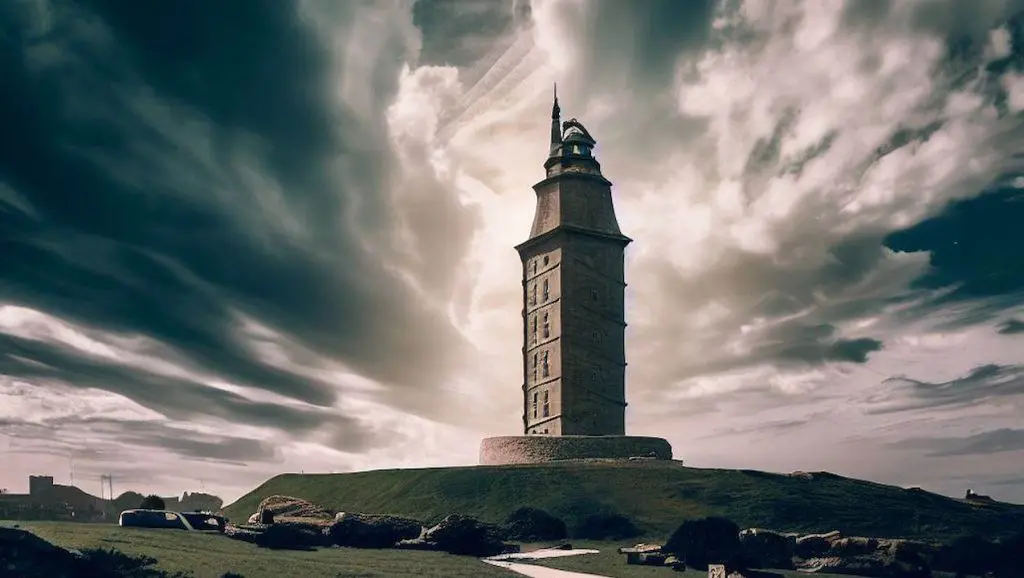
Inclusion in the Coat of Arms of A Coruña
The Tower of Hercules holds a prominent place in the coat of arms of the city of A Coruña. This emblematic symbol of the city is a testament to the tower’s historical and cultural significance.
The coat of arms of A Coruña features a blue shield with the silver tower, representing the Tower of Hercules, standing atop a skull and crossbones. The skull and crossbones represent the buried head of Hercules’ slain enemy, Geryon, according to local legend. The tower is crowned with a royal crown, signifying the city’s status as a royal borough.
The presence of the Tower of Hercules in the city’s coat of arms underscores its importance as a symbol of A Coruña. It serves as a constant reminder of the city’s rich maritime history and its connection to ancient civilizations. The coat of arms is used in official city documents, signage, and other representations of the city, reinforcing the tower’s presence in the daily life and identity of A Coruña.
The Tower in Contemporary Culture
The Tower of Hercules, with its rich history and cultural significance, has left an indelible mark on contemporary culture.
In 1992, the tower was the backdrop of a significant event when the oil tanker Aegean Sea ran aground and caught fire, causing a major oil spill. The image of the burning tanker behind the Tower of Hercules is a stark reminder of the environmental challenges faced by our oceans and the importance of maritime safety.
The tower’s grounds feature a sculpture garden, showcasing works by artists such as Pablo Serrano and Francisco Leiro. These sculptures add a cultural dimension to the tower, enhancing its appeal as a tourist attraction. The tower itself is the second-tallest lighthouse in Spain, after the Faro de Chipiona, and continues to serve as a beacon for ships navigating the North Atlantic.
The Tower of Hercules has also been recognized in the academic world. It is often studied in the fields of archaeology, architecture, and history for its unique blend of Roman and neoclassical design, its historical significance, and its continuous use as a lighthouse for nearly two millennia.
The Tower of Hercules is not just a historical monument but also a living part of contemporary culture. It serves as a symbol of A Coruña and Galicia, a subject of academic study, and a beacon guiding mariners along the treacherous North Atlantic coast.
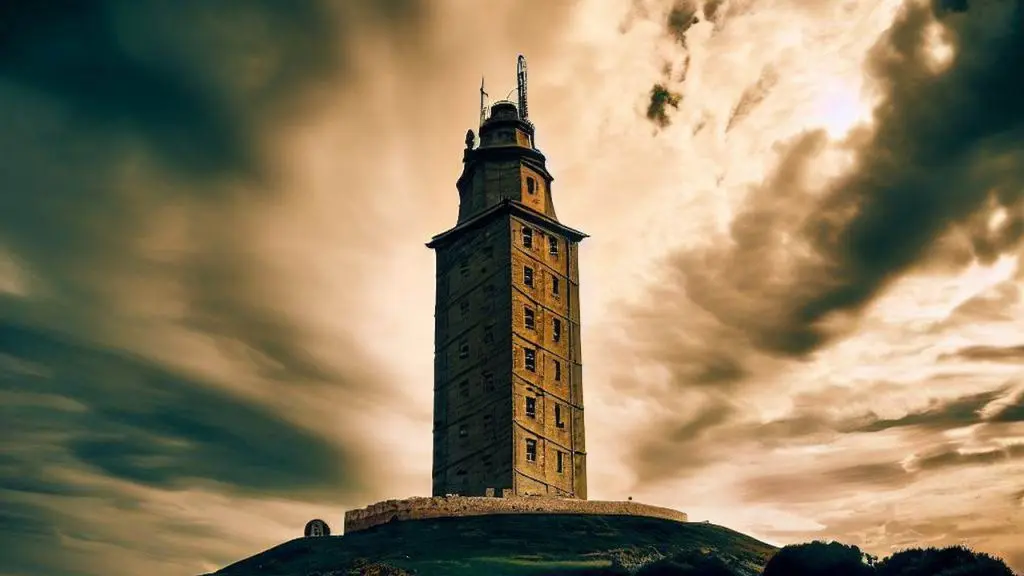
Visitor Experience
Visiting the Tower of Hercules is a unique experience that combines history, culture, and breathtaking views. The tower, which is located on a peninsula about 2.4 kilometers from the center of A Coruña, is surrounded by a large park area that offers a peaceful setting for a walk or picnic.
Upon arriving at the site, visitors can explore the surroundings, which include a sculpture park featuring works by Galician artists, a Muslim cemetery, and a compass rose representing the Celtic nations. The area around the tower also offers stunning views of the Atlantic Ocean and the city of A Coruña.
The tower itself is open to the public, and visitors can climb to the top to enjoy panoramic views of the surrounding area. The climb involves a series of stairs, but the effort is well worth it for the view from the top. Inside the tower, visitors can also see the original Roman construction and the later restorations.
Next to the tower is a visitor center where visitors can learn more about the history of the tower and its significance. The visitor center features exhibits and information panels, and guided tours are also available.
In terms of practical information, the Tower of Hercules is open every day, although opening hours can vary depending on the season. There is a small entrance fee to climb the tower, but visiting the surrounding park and the visitor center is free.
Overall, a visit to the Tower of Hercules offers a fascinating glimpse into the history and culture of A Coruña, as well as a chance to enjoy some of the best views in the city. Whether you’re a history buff, a nature lover, or simply someone who appreciates beautiful views, the Tower of Hercules is a must-visit when in A Coruña.
Practical Information for Visitors
Visiting the Tower of Hercules is a unique experience that combines history, culture, and breathtaking views. Here is some practical information to help you plan your visit:
Location: The Tower of Hercules is located on a peninsula about 2.4 kilometers from the center of A Coruña, in northwestern Spain. The tower overlooks the North Atlantic coast.
Opening Hours: The Tower of Hercules is open to the public every day. However, the opening hours can vary depending on the season. It’s recommended to check the official website for the most up-to-date information.
Entrance Fee: There is a small entrance fee to climb the tower. The surrounding park and the visitor center are free to visit.
Visitor Center: Next to the tower is a visitor center where you can learn more about the history of the tower and its significance. The visitor center features exhibits and information panels, and guided tours are also available.
Accessibility: The tower is accessible to people with disabilities. There is a parking area near the tower for visitors.
Facilities: There are restrooms and a small gift shop at the site. There are also several picnic areas in the surrounding park.
Guided Tours: Guided tours are available and offer a great way to learn more about the history and significance of the tower. It’s recommended to book in advance, especially during the peak tourist season.
Safety: The climb to the top of the tower involves a series of stairs. Visitors are advised to take care and use the handrails, especially in wet weather.
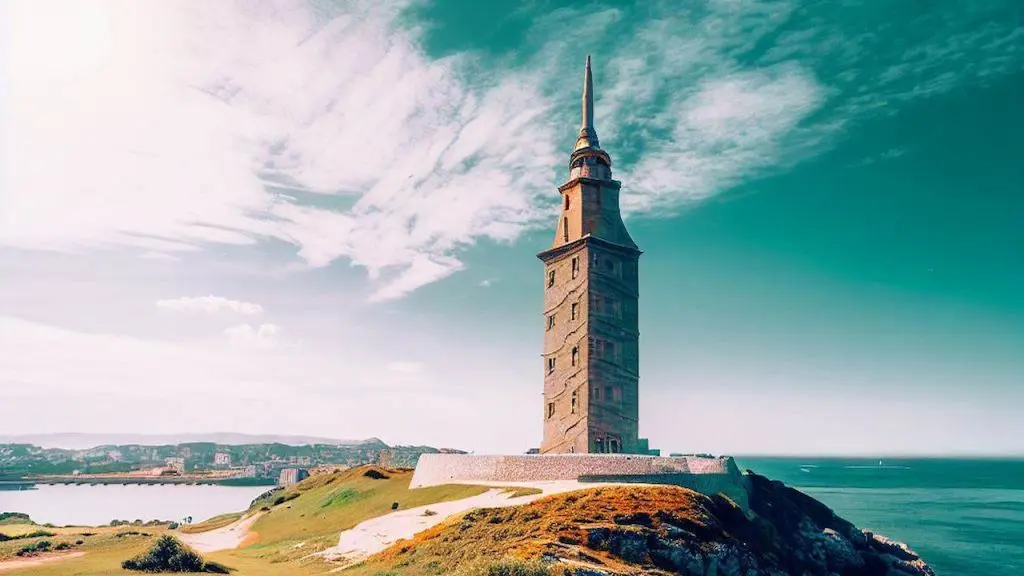
The Tower as a UNESCO World Heritage Site
The Tower of Hercules was inscribed as a UNESCO World Heritage Site in 2009, a testament to its historical, cultural, and architectural significance. The tower is the only fully preserved Roman lighthouse that is still used for maritime signaling, making it a unique monument in the world.
The UNESCO designation recognizes the Tower of Hercules as a testament to the use of lighthouses in antiquity and proof of the continuity of the Atlantic route from when it was first organized by the Romans, through a large part of the Middle Ages, and up to its considerable development in the modern and contemporary eras.
The tower’s designation as a World Heritage Site is based on Criterion (iii): “The Tower of Hercules is testimony to the use of lighthouses in antiquity. The Tower is also proof of the continuity of the Atlantic route from when it was first organised by the Romans, during a large part of the Middle Ages, and through to its considerable development in the modern and contemporary eras.”
The architectural integrity of the property, in the sense of a structurally complete building, and its functional integrity are satisfactory. While the authenticity of the central Roman core is certain, the authenticity of the building only makes sense when judged from the point of view of a technological property that has required numerous renovations and functional adaptations.
The conservation of the property is monitored to a good scientific level. The role of the Tower Management Plan Monitoring Committee needs to be upgraded by virtue of its being the coordinating authority for the management of the property.
Being a UNESCO World Heritage Site brings global recognition, increases tourism, and helps to secure funds for preservation. It also places an obligation on the Spanish authorities to protect and preserve the site for future generations. The Tower of Hercules’ status as a World Heritage Site underscores its universal value and the importance of preserving this unique monument.
Conservation Efforts
The conservation of the Tower of Hercules is of utmost importance due to its status as a UNESCO World Heritage Site and its historical and cultural significance. The tower is managed and protected under Spanish law, which ensures its preservation and maintenance.
The architectural integrity of the property, in the sense of a structurally complete building, and its functional integrity are satisfactory. While the authenticity of the central Roman core is certain, the authenticity of the building only makes sense when judged from the point of view of a technological property that has required numerous renovations and functional adaptations.
The conservation of the property is monitored to a good scientific level. In the final analysis, all the measures and projects presented form an acceptable management plan. The role of the Tower Management Plan Monitoring Committee needs to be upgraded by virtue of its being the coordinating authority for the management of the property.
Being a UNESCO World Heritage Site, the Tower of Hercules is subject to regular monitoring and assessment by UNESCO. This ensures that the site maintains the conditions of integrity and authenticity that warranted its inscription on the World Heritage List.
The conservation efforts for the Tower of Hercules involve a combination of national legislation, local management, and international oversight. These efforts ensure that the tower, a unique monument of Roman architecture and a symbol of A Coruña, is preserved for future generations to appreciate and learn from.
The Tower in Art and Literature
The Tower of Hercules has been a source of inspiration for artists and writers for centuries. Its imposing structure and the legends associated with it have made it a popular subject in various forms of art and literature.
In visual arts, the tower has been depicted in numerous paintings and sculptures. For instance, the grounds of the lighthouse feature a sculpture park with works by Galician artists. These sculptures add a modern touch to the ancient site and offer different interpretations of the tower and its history.
In literature, the tower has been mentioned in various works. One of the earliest known references to the lighthouse at Brigantium is by Paulus Orosius in “Historiae adversum Paganos,” written around 415–417 AD. In this work, Orosius describes the tower as a very tall lighthouse erected among a few commemorative works, for looking towards Britannia.
The tower has also featured in various myths and legends. According to one legend, the hero Hercules slew the giant tyrant Geryon after three days and three nights of continuous battle. Hercules then, in a traditional Celtic gesture, buried the head of Geryon with his weapons and ordered that a city be built on the site. This legend is often depicted in art and literature related to the Tower of Hercules.
The Tower’s Role in Navigation
The Tower of Hercules, being the oldest known extant lighthouse, has played a crucial role in navigation for nearly two millennia. Built in the 1st century, the tower is located on a peninsula about 2.4 kilometers from the center of A Coruña, Galicia, in northwestern Spain. It overlooks the North Atlantic coast, providing a beacon of light for ships navigating the perilous waters.
The Romans who conquered this region of Spain believed it to be, in a figurative sense, the end of the Earth – hence its name, Finisterra. This region is notorious for shipwrecks, earning it the name Costa da Morte, “Coast of Death”. The tower, standing 55 meters tall, would have been a vital navigational aid for ships sailing along the Atlantic route, helping them avoid the dangerous coastline and guiding them safely to the port.
The tower’s light, fueled by oil in ancient times, would have been visible for many miles out to sea. This would have been particularly important in an era when navigation was primarily done by sight. The light from the tower would have been a welcome sight for sailors returning from long voyages, signaling that they were nearing the safety of the harbor.
Even today, the Tower of Hercules continues to serve as a functioning lighthouse, its light guiding modern ships safely along the coast. Its enduring role in navigation is a testament to the ingenuity of its Roman builders and its importance as a maritime landmark.
Events and Festivals
The city of A Coruña, where the Tower of Hercules is located, is known for its vibrant cultural scene and hosts numerous events and festivals throughout the year. While not all of these events are directly related to the Tower of Hercules, they contribute to the overall visitor experience and offer additional attractions for those visiting the tower.
One of the most significant events in A Coruña is the ‘Maria Pita Festival’, held in August. This festival commemorates the defense of the city by Maria Pita, a local heroine, against the English Armada in 1589. The festival includes a wide range of activities, including historical reenactments, concerts, exhibitions, and street performances.
Another notable event is the ‘San Juan’ (St. John’s) festival in June. This festival, which marks the summer solstice, is celebrated with bonfires, music, and traditional dances. The festivities take place throughout the city, including the area around the Tower of Hercules.
In addition to these annual events, A Coruña also hosts various cultural events, sports competitions, and exhibitions throughout the year. These events offer visitors a chance to experience the local culture and enjoy a variety of entertainment options.
Please note that the dates and programs of these events can vary from year to year, so it’s recommended to check the official city or event websites for the most up-to-date information.
While the Tower of Hercules is a major attraction in its own right, the various events and festivals in A Coruña add to the appeal of a visit to the tower, offering a rich and diverse cultural experience.
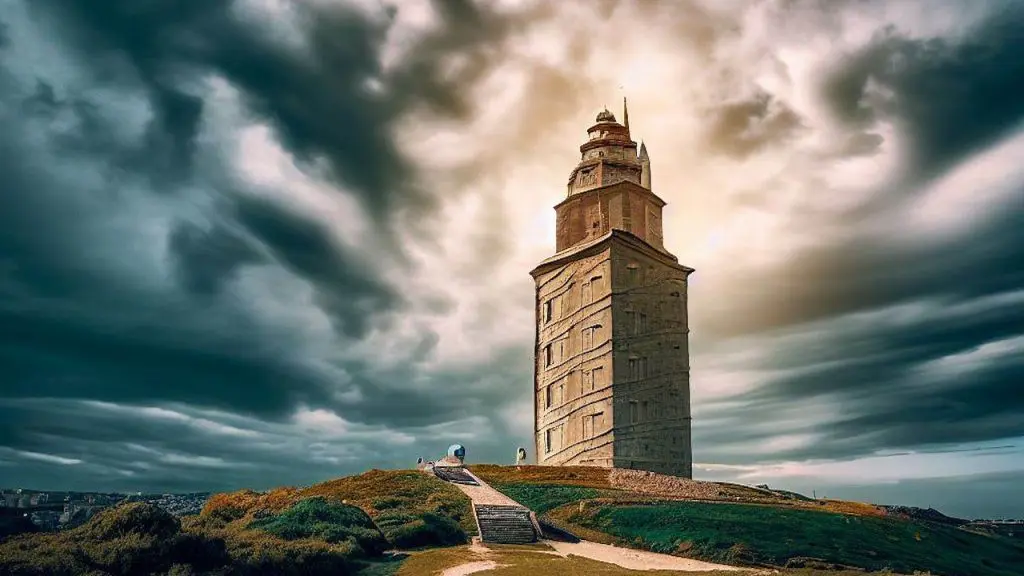
The Top 5 Albergues Nearest to the Tower of Hercules
As theTower of Hercules is a UNESCO World Heritage Site and one of the most popular tourist attractions in A Coruña, Spain. There are a variety of places to stay near the tower, from budget-friendly albergues to luxurious hotels.
If you are looking for a cheap place to stay, there are a few albergues located within a 10-minute walk of the tower. These albergues offer dormitory-style accommodation with shared bathrooms. Dorm beds typically start at €10 per night.
If you are looking for a more comfortable stay, there are a number of hotels located within a 15-minute walk of the tower. These hotels offer a variety of room types, including standard rooms, family rooms, and suites. Hotel rooms typically start at €50 per night.
No matter what your budget or preferences, there is a place to stay near the Tower of Hercules that is perfect for you.
For the Camino Pilgrim, here are the top 5 albergues nearest to the Tower of Hercules near A Coruña, Spain:
1. Albergue Santa Cruz
Review: This small and friendly albergue is located just a 7-minute walk from the Tower of Hercules. It has a shared kitchen, a laundry room, and a TV room. Dorm beds start at €10 per night.
Address: Rúa Santa Cruz, 10, 15001 A Coruña, Spain
Google maps: https://goo.gl/maps/oGa76vKr2Ydq3vit5
Phone: +34 981 20 03 51
Distance to Tower of Hercules: 0.5 kilometers (0.3 miles)
2. Albergue Regina Coeli
Review: This large and modern albergue is located a 15-minute walk from the Tower of Hercules. It has a shared kitchen, a laundry room, a common room with a TV, and a roof terrace with views of the city. Dorm beds start at €10 per night.
Address: Rúa Regina Coeli, 16, 15001 A Coruña, Spain
Phone: +34 981 22 33 90
Distance to Tower of Hercules: 1.2 kilometers (0.7 miles)
3. Albergue A Madroa
Review: This family-run albergue is located a 20-minute walk from the Tower of Hercules. It has a shared kitchen, a laundry room, and a common room with a TV. Dorm beds start at €10 per night.
Address: Rúa A Madroa, 35, 15001 A Coruña, Spain
Phone: +34 981 22 42 80
Distance to Tower of Hercules: 1.5 kilometers (0.9 miles)
4. Albergue de Peregrinos de A Coruña
Review: This large and well-organized albergue is located a 10-minute walk from the Tower of Hercules. It has a shared kitchen, a laundry room, a common room with a TV, and a library. Dorm beds start at €10 per night.
Address: Rúa San Andrés, 24, 15001 A Coruña, Spain
Phone: +34 981 22 36 00
Distance to Tower of Hercules: 0.8 kilometers (0.5 miles)
5. Albergue de Peregrinos de Monte de San Pedro
Review: This small and peaceful albergue is located a 25-minute walk from the Tower of Hercules. It has a shared kitchen, a laundry room, and a common room with a TV. Dorm beds start at €10 per night.
Address: Monte de San Pedro, 15009 A Coruña, Spain
Phone: +34 981 22 61 11
Distance to Tower of Hercules: 2.2 kilometers (1.4 miles)
How to Get to the Tower of Hercules from A Coruña?
There are several ways to travel from A Coruña to the Tower of Hercules, it’s not very far and you can walk or rent a bicycle if you have no luggage! Here is a list of the options:
Walking: The Tower of Hercules is located in the city center of A Coruña, so it is a short walk from most places in the city. The walk takes about 20 minutes from the center of town.
Public transportation: There are several bus lines that stop near the Tower of Hercules. The most convenient line is the Linea 11, which stops right in front of the tower. The bus fare is €1.50.
Taxi: Taxis are a convenient way to get to the Tower of Hercules, but they can be expensive. The fare from the center of town to the tower is around €5.
Car: If you are driving, there is a car park located next to the tower. The parking fee is €2 for the first hour and €1 for each additional hour.
Here is a table summarizing the travel options and their estimated travel times:
| Travel option | Travel time | Cost |
|---|---|---|
| Walking | 20 minutes | Free |
| Public transportation | 10 minutes | €1.50 |
| Taxi | 5 minutes | €5 |
| Car | 5 minutes | €2-4 |
Tower of Hercules FAQ’s
Q: When was the Tower of Hercules built?
A: The Tower of Hercules was built in the 1st century AD, during the Roman occupation of Spain.
Q: Who built the Tower of Hercules?
A: The Tower of Hercules was built by the Romans, possibly on the orders of the Emperor Trajan.
Q: How tall is the Tower of Hercules?
A: The Tower of Hercules is 55 meters (180 feet) tall.
Q: Is the Tower of Hercules still in use?
A: The Tower of Hercules is located in the Galician city of La Coruña, in Spain.
Q: Where is the Tower of Hercules located?
A: Yes, the Tower of Hercules is still in use as a lighthouse. It is the oldest operational lighthouse in the world.
Q: What is the significance of the Tower of Hercules?
A: The Tower of Hercules is a significant historical and cultural monument. It is a UNESCO World Heritage Site and a popular tourist destination.
Q: How can I visit the Tower of Hercules?
A: The Tower of Hercules is open to the public for visits. There is a small entrance fee.
Q: What are the opening hours of the Tower of Hercules?
A: The Tower of Hercules is open from 9:45 to 17:00 in autumn and winter, and from 10:00 to 21:00 in spring and summer.
Q: How many steps are there to the top of the Tower of Hercules?
A: There are 230 steps to the top of the Tower of Hercules.
Q: Is there a museum at the Tower of Hercules?
A: Yes, there is a museum at the Tower of Hercules. The museum exhibits artefacts related to the history of the tower, as well as art exhibitions.
